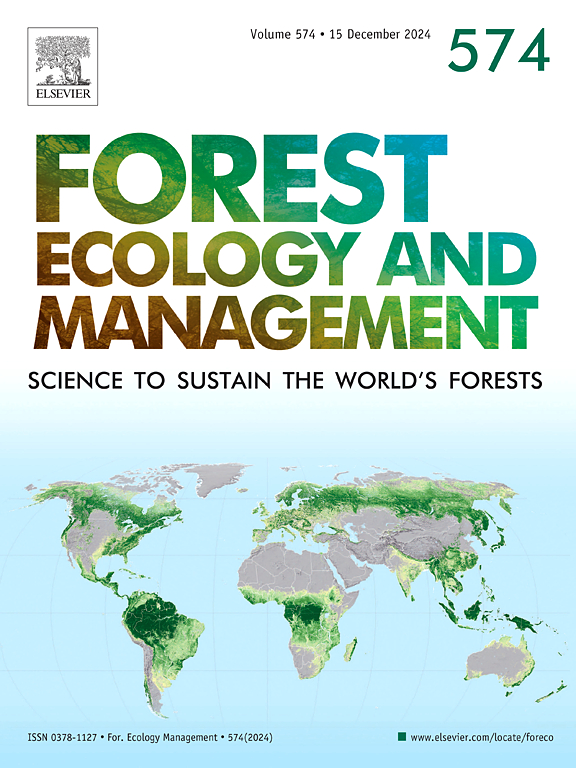在阿巴拉契亚中部狭长空地上种植的北方红橡树幼苗十年的生长和存活
IF 3.7
2区 农林科学
Q1 FORESTRY
引用次数: 0
摘要
高地橡树是贯穿阿巴拉契亚中部的重要树种。然而,橡树为主的森林很难再生。此外,现有的再生以橡树为主的森林的方法可能成本高昂,会破坏剩余的树木,而且可能需要在看到任何经济回报之前进行前期投资。需要在积极创造有竞争力的橡树提前繁殖和提供经济的短期收入之间提供折衷的方法。我们假设,带状清除方法,即将一半的区域切割成带状,剩余区域在5-10年后被移除,可以通过改善林下光照条件来创造有竞争力的提前繁殖,同时为土地所有者提供前期收入。2014年秋天,我们在阿巴拉契亚中部的一个高质量场地上收获了45 米(150 英尺)宽的从北向南的带状植物,并在第二年春天种植了360棵北方红橡树幼苗。幼苗在8个位置上种植,这些位置代表了光利用率的梯度。残条内的幼苗成活率最高,切条内的幼苗成活率最低,但切条内的平均生长率较高。2024年沿条形边缘幼苗成活率和生长组合最佳,约为70 %,边缘幼苗平均高度超过91 cm(竞苗最低高度)。我们还利用优势概率计算了在采收后20年再生优势和共优势栎树20% %库存所需的种植密度。在最初的带状收获后十年,根据种植幼苗的存活和生长情况,所需的种植密度为2500-4500棵/公顷,以达到20% %的放养目标。本文章由计算机程序翻译,如有差异,请以英文原文为准。
Ten-year growth and survival of northern red oak seedlings planted in a Central Appalachian strip clearcut
Upland oaks are a keystone group of trees throughout Central Appalachia. However, there has been difficulty in regenerating oak dominated forests. In addition, existing methods to regenerate oak-dominated forests can be costly, damaging to residual trees, and may require upfront investment before any economic return is seen. Methods which provide a compromise between actively creating competitive oak advance reproduction and providing economic near-term revenues are needed. We hypothesized that a strip clearcut method, where one-half of the area is cut in strips and the residual area is removed 5–10 years after, could create competitive advance reproduction due to improved understory light conditions while providing up front revenue for landowners. We harvested 45 m (150 ft) wide strips oriented north to south on a high-quality site in Central Appalachia in the fall of 2014 and planted 360 northern red oak seedlings the following spring. Seedlings were planted in 8 positions across residual/cut strip pairings which represented a gradient in light availability. Seedling survival was greatest within residual strips, and lowest within cut strips, although average growth was greater in the cut strips. Seedlings along strip edges had the best combination of survival (about 70 %) and growth with the average height of edge seedlings exceeding 91 cm (minimum height of competitive seedlings) in 2024. We also used dominance probabilities to calculate the required planting density to regenerate 20 % stocking of dominant and codominant oaks 20 years after harvest. Ten years following the initial strip harvests, based on the survival and growth of planted seedlings, the required planting density ranged from 2500–4500 trees/ha to meet a 20 % stocking goal.
求助全文
通过发布文献求助,成功后即可免费获取论文全文。
去求助
来源期刊

Forest Ecology and Management
农林科学-林学
CiteScore
7.50
自引率
10.80%
发文量
665
审稿时长
39 days
期刊介绍:
Forest Ecology and Management publishes scientific articles linking forest ecology with forest management, focusing on the application of biological, ecological and social knowledge to the management and conservation of plantations and natural forests. The scope of the journal includes all forest ecosystems of the world.
A peer-review process ensures the quality and international interest of the manuscripts accepted for publication. The journal encourages communication between scientists in disparate fields who share a common interest in ecology and forest management, bridging the gap between research workers and forest managers.
We encourage submission of papers that will have the strongest interest and value to the Journal''s international readership. Some key features of papers with strong interest include:
1. Clear connections between the ecology and management of forests;
2. Novel ideas or approaches to important challenges in forest ecology and management;
3. Studies that address a population of interest beyond the scale of single research sites, Three key points in the design of forest experiments, Forest Ecology and Management 255 (2008) 2022-2023);
4. Review Articles on timely, important topics. Authors are welcome to contact one of the editors to discuss the suitability of a potential review manuscript.
The Journal encourages proposals for special issues examining important areas of forest ecology and management. Potential guest editors should contact any of the Editors to begin discussions about topics, potential papers, and other details.
 求助内容:
求助内容: 应助结果提醒方式:
应助结果提醒方式:


